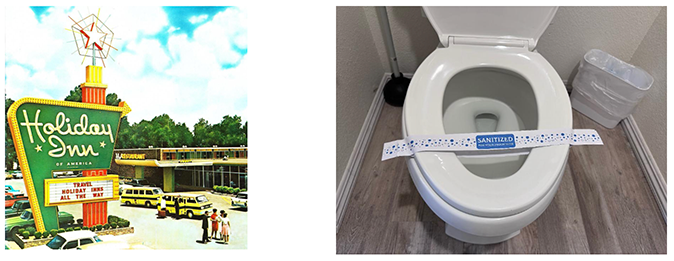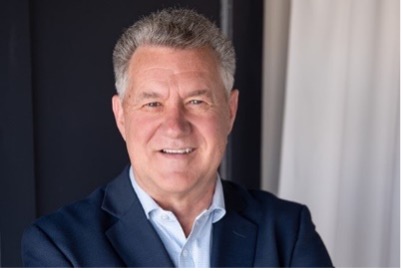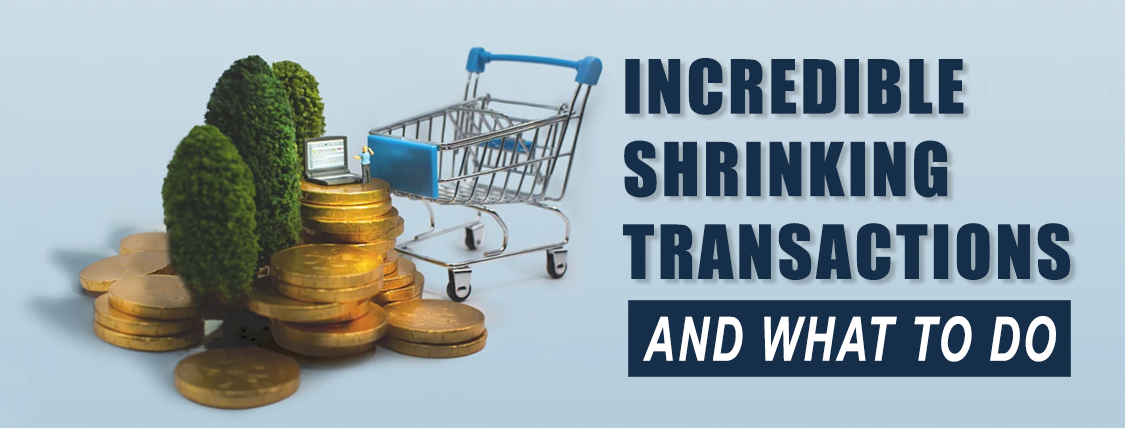Incredible Shrinking Transactions, and What to Do - Part 4
Incredible Shrinking Transactions, and What to Do - Part 4
by Sid Raisch
Part 4 - Sell What THEY Want to Buy - The CHEESE
[Continued from Part 3 - Click HERE to read from Group Blog]
We’ve covered a lot of ground so far in Parts 1, 2, and 3 of this article series. Be sure to click on the link above to review Part 3 or to catch up if you haven’t been following along with each part.
In this final Part 4 edition we are diving into problems causing the decline in our BIG 3 KPI’s.
Where did all those people go? We’re too busy in peak spring to notice who isn’t there anymore. This spring the loss of customer traffic is happening at a quickening pace. Why? The last of Baby Boomers are winding down, while the eldest of them are dying out. We’ve been experiencing the aging out of Boomers for a good while, and it is accelerating. The end of that process will come. Will we survive it? Will we gain enough new younger consumers through our doors before we run out of Boomers coming through? Why will younger customers come? How will we attract them? What will they buy? Why will they buy it? These are critical questions if we are to cross this chasm in our customer population of today to the one we need tomorrow because aging in to doing business with IGC’s is far from guaranteed.
This decline shows up most in the peak of the season when around 70% of customers come to IGCs. All of a sudden, like each year after the peak, more of them didn’t come, if we take the time to analyze the data to see what happened. We don’t notice mostly because increasing average transaction “makes up for it” and we settle for that when it really hasn’t made up for inflation and the higher prices it brings.
IGCs have been losing transactions for years (excepting 2020 and 2021). There are exceptions of course, but not many of you reading this are among the exceptions. Our industry has this problem - the same problem many other kinds of retailers are experiencing. Some are overcoming the issue and others won’t.
The BIG 3 KPI’s decline was a concern at Week 15, and now is a greater concern.
WDR BIG 3 KPI’s YTD Week 15: Revenue -4.7%, Avg. Sale -.5%, Tran. Ct. -4.2%
Now, after our Spring peak, the problem has increased because the 70% of customers who only come in spring have shown up, or haven’t.
WDR BIG 3 KPI’s YTD Week 22: Revenue -6.3%, Avg. Sale -0.9%, Tran. Ct. -5.4%
This would be worse if some younger customers were not offsetting the Boomer loss. We need many more of them.
Of particular concern is this year for the first time Average Sale is decreasing. This is probably due to Boomers buying less, and younger customers spending less while they age into their greater spending years.
Face it - the downward trend is indicative of changes in demographics and also psychographic values within our population.
We have a battle on our hands because the majority of people making up these younger generations have shown preference to national brands of products, chain stores, and the Internet where they buy them. The research cited in the previous parts of this article indicates IGCs are preferred as a source of plants by only 13% of GenX, Millennials, and GenZ. Guess who is preferred by the remaining 87%?
Can we build a bridge across the lower population of GenX to make up the necessary difference. We can, if we can find a way for them to know we exist, and convince them we have what they want so they’ll come. This will be an uphill battlefield, to say the least. Don’t take it for granted they’ll come. There’s a good analogy for this. Imagine we’re born holding two burlap bags, one in each hand. One is labeled Luck, and it is full. The other is labeled Wisdom, and it is empty. The goal is to get the bag of wisdom full enough to overcome the dwindling content of the bag of luck. We need all the luck we can get, and we best be holding on to it while exercising wisdom by paying closer attention to the interests and desires of younger generations.
Beginning with the end in mind, here we are, at the end of this article series, and the most important thing now is to have what younger generations want to buy. It’s not so much they don’t want to buy what we have, but they have different reasons for buying.
Younger consumers don’t know our jargon and don’t want to know - just like they don’t want to memorize phone numbers, algebra, proper punctuation, or to read or write cursive. They certainly don’t have to know those things to get along quite nicely in this world today. Get over it. They are however, generally speaking, interested in things much more important to them. This is their love language and we need to be speaking it for them to discover we exist, and to believe we have what they want to satisfy the desires they are trying to achieve for themselves.\
What Desires?
- The desire to not be so consumed with work that it engulfs their sense of identity, their lifestyle, their time for themselves.
- The desire to eat whole foods (not processed), without ingredients nobody can pronounce.
- The desire to live and let live without discrimination, hatred, or condemnation.
- The desire to live without fear of chemically caused cancers, autoimmune disease, neurological illness, heart disease, diabetes, and more.
- The desire to clean up this world and to leave a better one for their kids.
- The desire to invest in more goods that are produced more sustainably using less resources, with less negative environmental impact.
- The desire to invest in design and style that provides positive emotional well-being.
- The desire for collecting experiences over collecting things.
- The desire for contentment through fulfillment and experiences more than for material things.
- The desire to ____________________________________________________. (Fill in the blank with whatever it is you or if you’re a Boomer, whatever you believe younger consumers are trying to gain and achieve.)
That which they desire to have or achieve is the CHEESE. Of course, different people develop tastes for different kinds of cheese. American, Cheddar, Jack, and Colby are cheeses of the masses. Gruye, Feta, Brie, Camembert, Asiago, Emmental, Cotija, Edam, Fontina, Ricotta, Burrata, Bleu, Gorgonzola, Parmesan, and others appeal to more discriminating palettes, which means they’re buying at a different level above price and convenience - they’re buying the intangible ideals and benefits of the products.
Tangibilizing Intangibles - Many decades ago, as the post-WW2 Dwight D. Eisenhower highway system developed, Americans began traveling by car. The hotels of the day were mostly mom & pop operations and were highly variable in cleanliness. The industry was fragmented and offered no consistency of choice. Kemmons Wilson had an idea of creating uniformity and trust among travelers, creating Holiday Inn with operating systems and standards the consumer could trust.
He had a problem. The most important concern of travelers was cleanliness. How do you know the room is really clean? The answer was a strip of paper placed across the toilet seat as the housekeeper completed their jobs to make tangible the intangible standard of clean.

How does this apply to selling plants? It’s an example of applying an important principle. How do we make tangible the expected intrinsic benefits of what we offer younger consumers?
Intangibilizing Tangibles of Plants - Instead of selling varieties of plants with prices determined and compared by the brand name and size of pots, what if we started marketing the intangible ideals and benefits of them and invested in doing so as if we believed those benefits were real?
Consumerism was enjoyed by boomers in their pursuits as they caught up and kept up with friends and neighbors at shopping centers and malls with recreational shopping collecting the things they saw on tv and heard about on radio to fill their homes and lives, and eventually - bigger houses and storage units because they collected so much stuff. This isn’t the pursuit of Millennials and GenZ who have a more intentional desire when acquiring products often choosing the intrinsic intangible benefits of bespoke quality over the price. They choose to acquire fewer things as they choose to have better things. The difference isn’t the things that have been acquired by Boomers vs. younger generations, it’s about the reasons they choose to buy. The difference is in the reasons, and the process to acquire. Younger generations “Purchase With A Purpose”, satisfying their purposes and not just meeting basic needs and desires.
Take a look at the marketing messages of our industry. It’s almost all about us and our stuff, and nearly nothing about what younger consumers are interested in - THE CHEESE.
When the younger consumer desires are not the tangible aspects of our products (color for the sake of color), what CHEESE can we use to attract them? The CHEESE isn’t the products we’re trying to sell and certainly isn’t low prices, discounts, coupons, BOGOs, or other gimmicks that will never cause someone to want what they otherwise don’t want in the first place. Gimmick approaches to marketing cause low margins, high shrink, and lower profit from people who already want to buy.
Marketer’s Mantra - “To communicate information causing the consumer to want to buy.”
The CHEESE is the Intangibles within the products we buy. Pollinators are almost universally appreciated today. Interest ranges from childlike wonder at the beauty of a butterfly which is really nothing new, to deep understanding and appreciation of the circle of life which would not be possible without pollination. For most humans though, our knowledge and understanding is near the surface, where it is easy to engage.
Interest in pollinators has been going for a good long time, having been kicked up a bunch of notches with the 2013 Wilsonville Oregon Bee Kill triggering a targeted backlash to the use of pesticides to grow flowers sold in box stores. The Home Depot became the primary target of a threatened boycott if growers weren’t required to stop using neonicotinoids, a systemic type of long-lasting chemical accused of endangering pollinators. A broadly supported public relations response by the National Pollinator Garden Network, and its Million Pollinator Garden movement to challenge consumers nationwide to plant more food and habitat sources for pollinators leveraged the interest, providing resources for spreading their pro-pollinator (and anti-chemical) messaging through media including garden writers, and into public school curriculum. Awareness increased and by early 2020 had become entrenched in consumer minds, particularly among children and young adults who are now in their rising income and spending years. This messaging dovetailed nicely with the Sustainability Movement that had been increasing as a response to Global Warming, which became better known as a less controversial and broader interest to positively affect Climate Change.
Promoting Pollinators
We’ve been promoting pollinators but only as a sideline for the most part, with the promotion of plants that attract pollinators still being defined as “perennials” and other pollen and nectar-bearing plants that provide the habitat and food sources for the butterflies, birds, bees and other pollen distributing creatures.
- Simplify to Multiply Pollinator Impact - Marketing is in itself the problem of marketing because across our society it has degraded to being social media, (which is media, not marketing). The message that is carried across media is the tangible aspect of marketing and has benefits according to how effectively it is crafted and delivered across a range of media, but mostly how well those messages are crafted to compel a consumer to buy a product so the result can be measured in terms of effectiveness of the effort. The problem with social and other digital marketing is this - the sellers of these media want us to buy what they measure, not what matters to us. They want us to buy exposure, views, clicks, likes, comments, forwards, and so forth - which may or may not result in the consumer buying anything. Content messages are being produced en masse with the goal of increasing these features of marketing, instead of to deliver messages which matter to the consumer in such a way they actually make a purchase.
- Space for Pollinators - Moving beyond media space, giving room in the physical store and web store to deliver in-store messaging supporting the sustainability through pollinator-supporting messaging connects all the dots required for a transaction to take place. A transaction itself isn’t a relationship - it is more of a one-night stand. Creating communication to inform leads to a relationship with Millennials and Gen Z that rides on their long-standing relationship with pollinators and their source - nature, with the plant as the connector of the two. With the seller as the distributor, aka dealer of the pollinator drug of choice.
- People, Plants, and Products for Pollinators - Millennials and Gen Z seek out people who can help them on their journey to providing food and habitat for pollinators, and changing the part of the world they can for the better. Knowledge of the ecosystem of taking plants through paces to produce a better environment has to pass the transparency and authenticity screening. Which bees matter most and why? Which fertilizer is best, because it doesn’t negatively affect the environment? Why don’t we know this stuff better than many customers? It’s not just access to the Internet because we all have Google in common. It’s where our interest is and that is in the WHY we believe plants matter.
We’re in a war for the minds of the younger consumer because they’re not just buying products, they’re buying solutions to problems I hope are becoming clearer.
We are standing on the side of the battlefield fighting for our own existence.
On one side of the battlefield stands Goliath - chain and big box home improvement retailers.
We are David, and standing here on the other side of the battlefield in hope, vastly outnumbered, and with few resources.
Younger consumers don’t think of us or experience our stores as often as they think of and experience chain and box retailers. Most of them are unaware of our existence.
A few rocks are useless against Goliath. We need the stones to stand up for ourselves, around intrinsic benefits fighting for the people who need plants in their lives - as if our very existence depends on it.
It frustrates me when people say things like, “Our industry’s products are not essential. Plants are a luxury because we’re not milk and bread and gasoline”.
The facts are different from this statement.
Plants are proven to be much more important than those things which are definitely non-essential. They’re wrong. Plants are absolutely essential and there is research and facts to prove it. If we can’t simply accept this truth and stand on that ideal like the rock it is, we’re going to lose this war for the consumer to the chains and boxes.
We must rethink the way we communicate our value and how we invest in marketing to deliver the truth and gain awareness of the existence of IGCs in the declining Big 3 KPIs.
In my next article, we are starting a new series as we’re going to get to the truth of what’s going on (or better said, what’s not going on) in marketing and why it isn’t working.


Before procrastination or other busyness steals another year from you Text or Call 937-302-0423 or send an email to [email protected] .
Sid Raisch is an advocate for family business leading growth, change, and results throughout US horticulture. Redefining the business future for consumer horticulture by understanding how the end-to-end supply chain needs to be redirected is a skill Sid has honed into an art. He has understanding and insight through inquisitive observations and extensive experience and has served as a trusted advisor helping transform both national and local businesses into more profitable and sustainable businesses. Developing national and international educational programs that create change in culture, community and company provides Sid venues with a front row seat creating effective and innovative business models.

Sid is a Certified Value Builder System Advisor, and currently serves as Chief Strategist and the Swiss Army Knife of Consultants to The Garden Center Group clients. Contact Sid at [email protected] or call or text 937-302-0423.
REMEMBER: Your interaction (by phone and email) with Group Service Providers such as Sid Raisch, Tim Quebedeaux, Jean Seawright, John Kennedy, and of course Danny Summers are included in your retainer!


